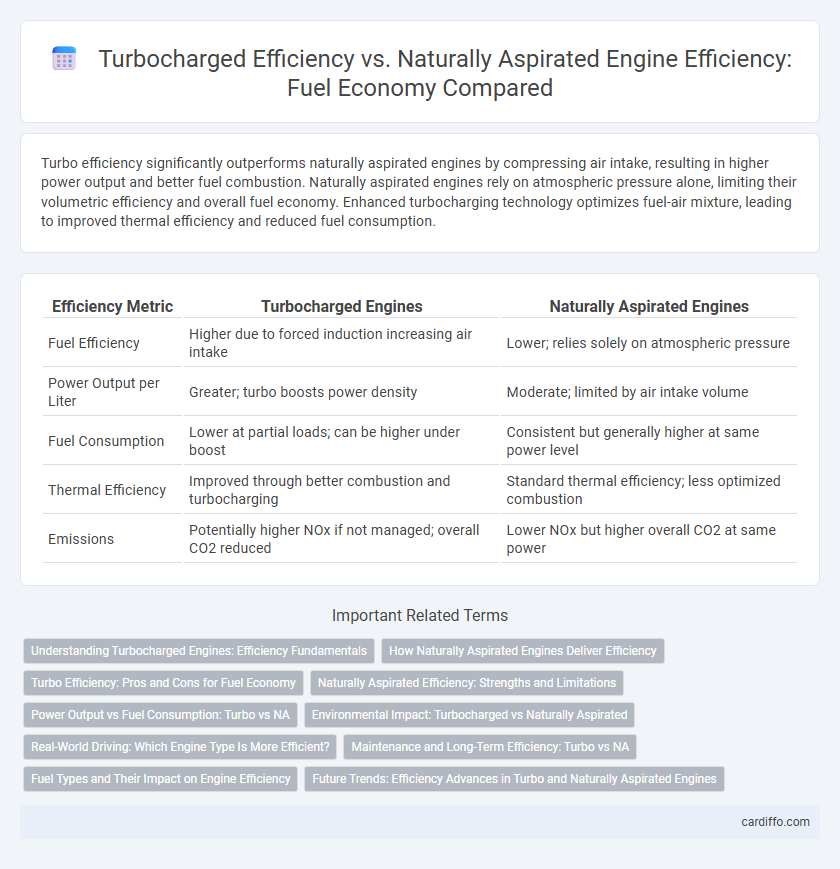Turbo efficiency significantly outperforms naturally aspirated engines by compressing air intake, resulting in higher power output and better fuel combustion. Naturally aspirated engines rely on atmospheric pressure alone, limiting their volumetric efficiency and overall fuel economy. Enhanced turbocharging technology optimizes fuel-air mixture, leading to improved thermal efficiency and reduced fuel consumption.
Table of Comparison
| Efficiency Metric | Turbocharged Engines | Naturally Aspirated Engines |
|---|---|---|
| Fuel Efficiency | Higher due to forced induction increasing air intake | Lower; relies solely on atmospheric pressure |
| Power Output per Liter | Greater; turbo boosts power density | Moderate; limited by air intake volume |
| Fuel Consumption | Lower at partial loads; can be higher under boost | Consistent but generally higher at same power level |
| Thermal Efficiency | Improved through better combustion and turbocharging | Standard thermal efficiency; less optimized combustion |
| Emissions | Potentially higher NOx if not managed; overall CO2 reduced | Lower NOx but higher overall CO2 at same power |
Understanding Turbocharged Engines: Efficiency Fundamentals
Turbocharged engines enhance fuel efficiency by forcing extra air into the combustion chamber, enabling a higher air-fuel ratio and more complete combustion than naturally aspirated engines. This increased air density improves power output without significantly raising fuel consumption, making turbocharged engines more efficient during partial load conditions. Understanding the thermodynamic advantages of turbochargers reveals their ability to reclaim exhaust energy, which naturally aspirated engines cannot utilize, leading to better overall fuel economy.
How Naturally Aspirated Engines Deliver Efficiency
Naturally aspirated engines deliver efficiency by relying on atmospheric pressure to draw air into the combustion chamber, resulting in a simpler design with fewer components that reduce parasitic losses. These engines typically achieve better fuel economy at low to mid-range RPMs due to more consistent airflow and precise fuel-air mixture control. Their efficiency stems from optimized combustion timing and mechanical simplicity, limiting the additional fuel consumption caused by turbo lag or boost-related pumping losses.
Turbo Efficiency: Pros and Cons for Fuel Economy
Turbo efficiency enhances fuel economy by increasing air intake and combustion efficiency, resulting in more power from less fuel compared to naturally aspirated engines. Turbocharged engines often deliver better mileage under varied driving conditions but may experience turbo lag and higher maintenance costs that can offset fuel savings. Proper tuning and modern turbo technology mitigate these drawbacks, making turbos a favorable choice for improved fuel economy.
Naturally Aspirated Efficiency: Strengths and Limitations
Naturally aspirated engines deliver fuel efficiency through simpler design and consistent air-fuel mixture, minimizing pumping losses and improving fuel consumption at steady speeds. Their strengths include reliable performance without the complexity or maintenance demands of turbochargers, yielding better fuel economy in low to mid-range RPMs. Limitations arise in power density and efficiency at higher loads, where lack of forced induction reduces volumetric efficiency and overall fuel-saving potential compared to turbocharged engines.
Power Output vs Fuel Consumption: Turbo vs NA
Turbocharged engines deliver higher power output by forcing more air into the combustion chamber, enabling better fuel atomization and more efficient combustion compared to naturally aspirated (NA) engines. While turbos improve fuel efficiency at partial loads by recovering exhaust energy, they often consume more fuel under heavy acceleration due to increased boost pressure. Naturally aspirated engines maintain consistent fuel consumption patterns but typically produce lower power output per unit of fuel, making turbos more effective for balancing power and fuel economy in performance applications.
Environmental Impact: Turbocharged vs Naturally Aspirated
Turbocharged engines improve fuel efficiency by forcing more air into the combustion chamber, resulting in better fuel combustion and reduced carbon emissions compared to naturally aspirated engines. Naturally aspirated engines typically consume more fuel to achieve similar power output, leading to higher greenhouse gas emissions and environmental impact. The enhanced efficiency of turbocharged engines contributes to lower fuel consumption and decreased air pollution, supporting stricter emissions regulations and environmental sustainability goals.
Real-World Driving: Which Engine Type Is More Efficient?
Turbocharged engines typically offer higher fuel efficiency in real-world driving due to better air-fuel mixture control and increased power output from smaller engine displacement. Naturally aspirated engines, while simpler and more reliable, tend to consume more fuel under similar driving conditions because they lack forced induction to optimize combustion. Studies show turbo engines can improve fuel economy by up to 20% during varied driving scenarios, making them more efficient for everyday use.
Maintenance and Long-Term Efficiency: Turbo vs NA
Turbocharged engines often require more frequent maintenance due to increased complexity, higher operating temperatures, and turbocharger wear, impacting their long-term efficiency. Naturally aspirated engines generally offer simpler design and more straightforward maintenance, contributing to more consistent fuel efficiency over time. However, properly maintained turbo engines can achieve superior fuel economy and performance, balancing initial upkeep demands with long-term efficiency gains.
Fuel Types and Their Impact on Engine Efficiency
Turbocharged engines utilize forced induction to increase air density, allowing for more efficient combustion of fuel types such as high-octane gasoline, which enhances power output and fuel economy compared to naturally aspirated engines. Naturally aspirated engines rely on atmospheric pressure, often requiring richer fuel mixtures to prevent knocking, leading to less efficient fuel consumption, especially with lower-octane fuels. The choice of fuel type directly impacts combustion efficiency and emissions, with turbo engines benefiting more from advanced fuels like ethanol blends or premium gasoline due to their higher compression and combustion temperatures.
Future Trends: Efficiency Advances in Turbo and Naturally Aspirated Engines
Future trends in fuel efficiency highlight significant advancements in turbocharged engines through improved variable geometry turbochargers and advanced direct injection systems, enhancing power output while reducing fuel consumption and emissions. Naturally aspirated engines benefit from innovations in lightweight materials, optimized combustion chamber design, and variable valve timing technologies that boost thermal efficiency and lower fuel use. Combining these developments, both engine types are poised to meet stricter environmental regulations with improved fuel economy and reduced carbon footprint in upcoming automotive models.
Turbo Efficiency vs Naturally Aspirated Efficiency Infographic

 cardiffo.com
cardiffo.com